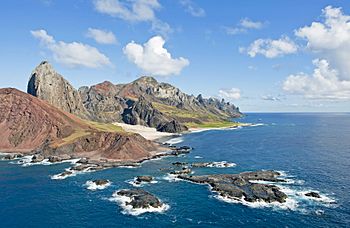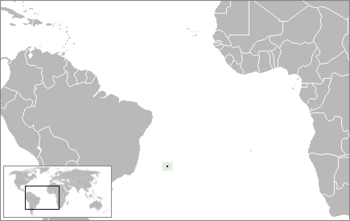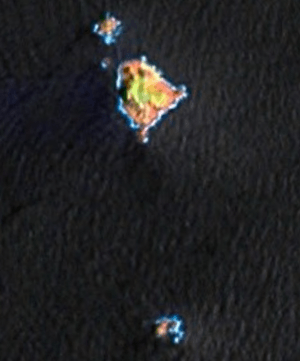Trindade and Martin Vaz facts for kids

Rocky cliffs of Trindade Island
|
|
 |
|
| Geography | |
|---|---|
| Location | Atlantic Ocean |
| Coordinates | 20°31′30″S 29°19′30″W / 20.52500°S 29.32500°W |
| Archipelago | Arquipélago de Trindade e Martin Vaz |
| Total islands | 5 |
| Major islands | Trindade; Martin Vaz |
| Area | 10.4 km2 (4.0 sq mi) |
| Highest elevation | 620 m (2,030 ft) |
| Highest point | Pico do Desejado |
| Administration | |
| Region | Southeast |
| State | Espírito Santo |
| Administration | 1st Naval District of the Brazilian Navy |
| Demographics | |
| Population | 32 (2009) |
| Additional information | |
| Time zone |
|
| Official website | Brazilian Navy First Naval District |
The Trindade and Martin Vaz islands (called Trindade e Martim Vaz in Portuguese) are a group of islands far out in the South Atlantic Ocean. They are about 1,100 kilometers (680 miles) east of the Brazilian state of Espírito Santo. These islands are part of Brazil.
The whole group of islands covers an area of 10.4 square kilometers (4 square miles). Only 32 people live there, who are members of the Brazilian Navy. The archipelago has five main islands and several smaller rocks. Trindade is the biggest island, taking up 10.1 square kilometers (3.9 square miles). About 49 kilometers (30 miles) east of Trindade are the tiny Martin Vaz islets, which are much smaller.
These islands were formed by volcanoes and have rough, rocky land. Most of them are bare, except for the southern part of Trindade. A Portuguese explorer named Estêvão da Gama found them in 1502. They belonged to Portugal until Brazil became independent in 1822. For a short time, from 1895 to 1896, the United Kingdom took over Trindade. During this time, it was known as South Trinidad.
The islands are quite isolated. They are about 2,100 kilometers (1,300 miles) southwest of Ascension Island. They are also 2,550 kilometers (1,580 miles) west of Saint Helena. The coast of Africa is 4,270 kilometers (2,650 miles) away.
Contents
Exploring the Islands: Geography
The Trindade and Martin Vaz archipelago includes several islands. Each one has its own special features.
- Ilha da Trindade (which means "Trinity Island" in Portuguese) is the largest.
- Ilhas de Martim Vaz is a group of smaller islands:
- Ilha do Norte ("North Island") is 75 meters (246 feet) high.
- Ilha da Racha ("Crack Island") or Ilha Martim Vaz is the biggest of the Martin Vaz group. It is 175 meters (574 feet) high. Its shores are covered with large rocks.
- Rochedo da Agulha ("Needle Rock") is a flat, round rock. It is 60 meters (197 feet) high.
- Ilha do Sul ("South Island") is a tall, rocky peak. It is the easternmost point of Brazil.
Trindade Island: A Volcanic Landscape

The island of Trindade is 10.3 square kilometers (4 square miles) in size. It sits at the end of a long chain of underwater volcanoes. This chain stretches about 1,000 kilometers (620 miles) from the coast of Brazil.
Trindade is a mountainous island made of volcanic rock. It has many steep volcanic peaks. The highest point is Pico Desejado, which is 620 meters (2,034 feet) high. Other nearby peaks include Pico da Trindade (590 meters or 1,936 feet) and Pico Bonifácio (570 meters or 1,870 feet).
The youngest volcanic activity happened at Vulcão do Paredão. This volcano created a cone with lava flows that are very recent in geological time. There are still parts of its crater left. Lava flowed from this cone to the north, creating a jagged coastline and small islands offshore.
For a long time, Trindade Island was covered by a forest of Colubrina glandulosa trees. These trees could grow up to 15 meters (49 feet) tall. But after 1850, people brought animals like goats, pigs, and sheep to the island. They also cut down many trees. This led to the complete loss of the forest. The soil eroded, and many natural springs dried up.
Today, there is a small settlement on the north shore of Trindade. It's called Enseada dos Portugueses. This is where the 32 Brazilian Navy personnel live.
Amazing Animals of the Archipelago
The Trindade and Martin Vaz islands are very important for wildlife. They are the main place in Brazil where green sea turtles lay their eggs.
Many seabirds also breed here. These include special kinds of Great frigatebird and Lesser frigatebird that are found only in this area. It is also the only place in the Atlantic Ocean where the Trindade petrel breeds. Scientists have also confirmed that Humpback whales use Trindade Island as a nursery for their young.
Island History: From Discovery to Today
Early Explorers and Claims (16th to 18th Century)
The Trindade and Martin Vaz Islands were found in 1502 by Portuguese sailors led by Estêvão da Gama. Like Brazil, they became part of the Portuguese Empire.
Many people visited Martin Vaz over the centuries. One famous visitor was the English astronomer Edmund Halley. He claimed the island for the British Monarchy in 1700. Even in 1939, wild goats and pigs, whose ancestors were left by Halley, could still be found on Martin Vaz.
In 1781, a British ship called HMS Rattlesnake was shipwrecked on Trindade. The ship's commander, Philippe d'Auvergne, and about 50 sailors and a French woman stayed on the island. They lived there for a year, surviving on supplies and what they could find. Another British ship rescued them in late 1782.
Captain La Pérouse, a French explorer, also stopped at Trindade in 1785.
Later Events and Sovereignty (19th to 20th Century)
In 1889, an adventurer named Edward Frederick Knight went to Trindade looking for treasure. He didn't find any, but he wrote a detailed book about his trip called The Cruise of the Alerte.
A few years later, in 1893, an American named James Harden-Hickey claimed Trindade Island for himself. He even declared himself "James I, Prince of Trinidad". He had big plans, including designing stamps, a flag, and a coat of arms. He even tried to sell bonds to fund his new country! However, the rest of the world mostly ignored or made fun of his idea.
In July 1895, the British tried again to take control of Trindade. They wanted to use it as a station for underwater telegraph cables. But Brazil worked hard with Portugal's help to keep the island. Brazil successfully got Trindade Island back.
To show that the island clearly belonged to Brazil, a special landmark was built on January 24, 1897. Today, the Brazilian Navy has a permanent base on the main island. This shows Brazil's continued presence there.
In July 1910, the ship Terra Nova arrived at the island. This ship was carrying Captain Robert Falcon Scott's last expedition to Antarctica. Some members of Scott's team explored the island for scientific reasons. Their observations were included in a book called The Worst Journey in the World.
In August 1914, during World War I, the German Navy set up a supply base for its warships near Trindade. On September 14, 1914, a British ship, HMS Carmania, fought a German ship, SMS Cap Trafalgar, near Trindade. This battle was known as the Battle of Trindade. The British ship sank the German one, but it was also badly damaged.
See also
 In Spanish: Trinidad y Martín Vaz para niños
In Spanish: Trinidad y Martín Vaz para niños

